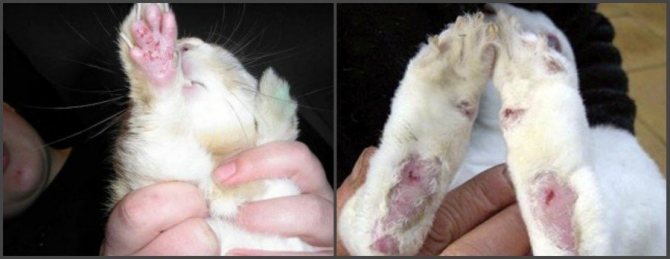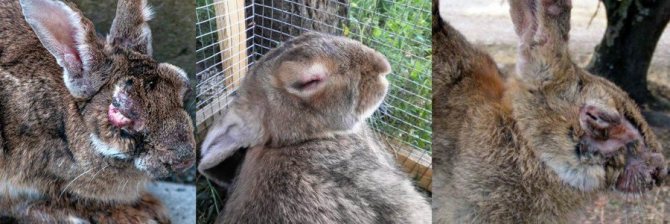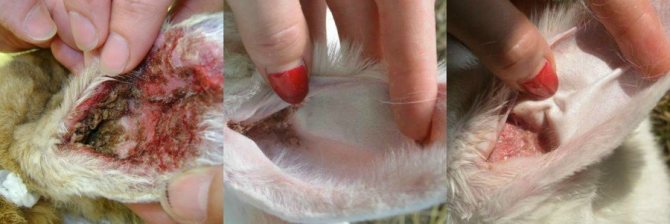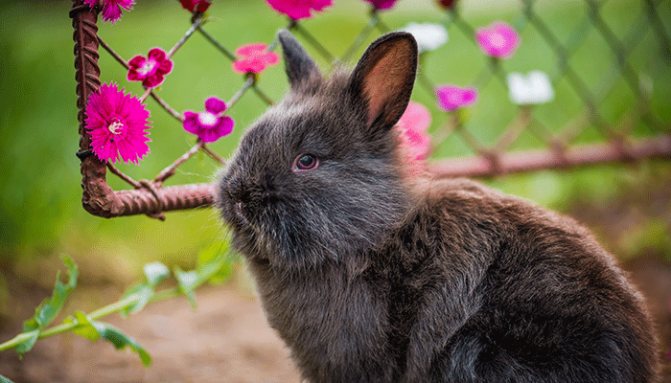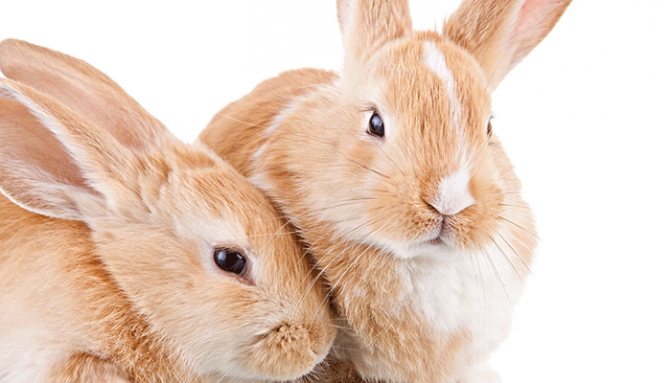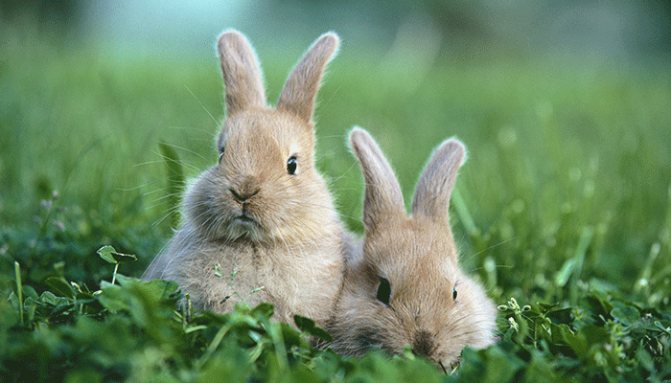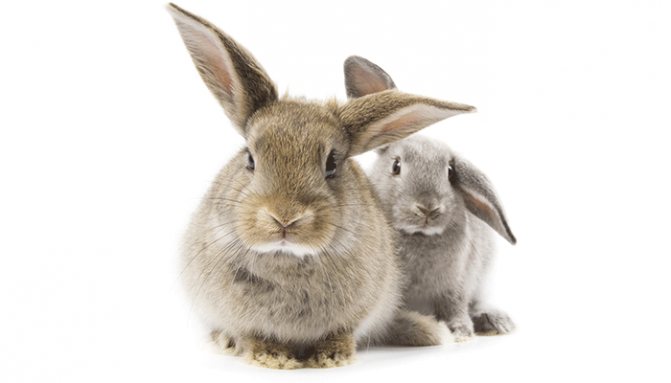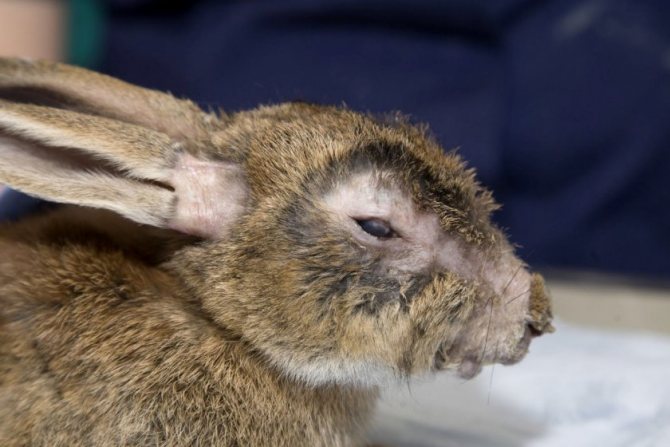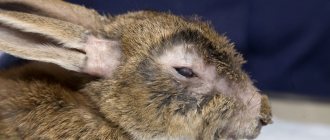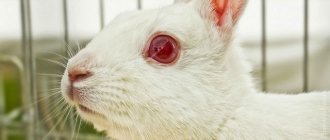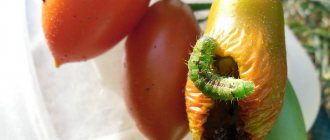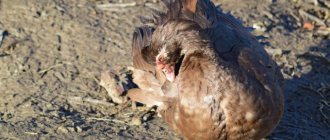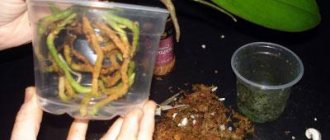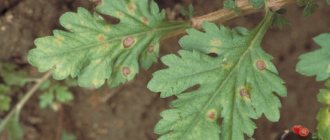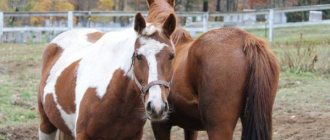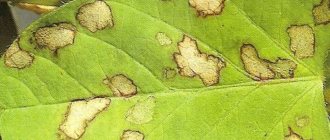Differences between a sick rabbit and a healthy one: signs of an unhealthy animal
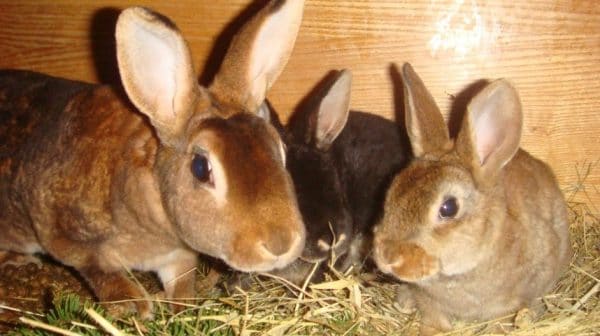
Rabbit breeding is profitable, but the animals need careful grooming
Description of a healthy individual:
- no problems with appetite;
- no discharge from the ears and nose;
- feces of a dark color, rounded (similar to peas);
- dark urine (may vary depending on feed);
- smooth coat;
- manifestation of activity.
Signs of a sick animal:
- lethargic behavior, constant sitting without movement;
- hard breath;
- loss of hair in large quantities;
- the presence of wounds on the skin;
- purulent discharge from the ears and nose;
- a bloated stomach (a symptom occurs when the intestines are dysfunctional).
Pasteurellosis
Pasteurellosis or hemorrhagic disease of rabbits is an infection of domestic and wild representatives of this species of animals, which is characterized by the development of signs of septicemia (blood poisoning) in an acute course. It is caused by a microbe - Pasteurella. Mortality can range from 10 to 85%. In addition to rabbits, even a person can get sick with pasteurllosis.
From the moment pasteurella enters the body until the first symptoms appear, an average of several hours to three days pass. Hemorrhagic disease (pasteurellosis) of rabbits develops in over -, under -, and acute, as well as chronic forms.
In the hyperacute form, any signs do not have time to develop - the animal dies within a few hours after infection.
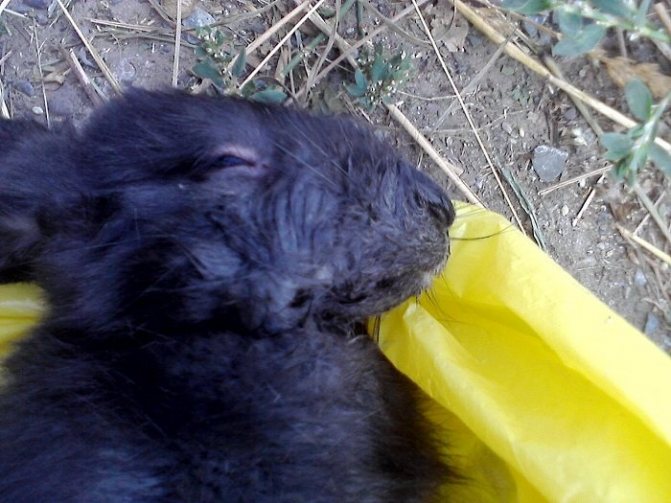

Acute pasteurellosis is determined by the following symptom complex:
- Body temperature rises to 41 ° C, and a couple of hours before death, on the contrary, drops to 35–36 ° C.
- Breathing becomes difficult, a runny nose appears, the animals sneeze, nasal discharge may be mixed with blood.
- The wool fades, ruffles.
- Rabbit diarrhea appears in half the cases, sometimes it can be bloody.
Death occurs on average from 12 hours from the moment of infection to a week.
Symptoms of the subacute form:
- The body temperature rises, but not as critical as in the acute form.
- The pulse quickens (more than 200 beats per minute).
- The mucous membranes become reddened.
- Lack of appetite.
- Unsteadiness of gait, sometimes cramps, tremors of various muscle groups.
- Sometimes there is vomiting and diarrhea in a rabbit.


Hemorrhagic disease of rabbits, its chronic form is determined by the following signs:
- The development of inflammation of the mucous membranes of the eyes and nose, accompanied by the release of outflows.
- Pneumonia develops (breathing is heavy, there is a cough, wheezing).
- Sometimes ear inflammation occurs.
- The joints swell.
- Abscesses develop in the subcutaneous tissue, which, after 1.5 -3 months (if no measures are taken), open up and heal on their own.
- Animals lose weight a lot.
Many individuals recover with this course of the disease, but for a very long time they regain the necessary condition.
It makes sense to engage in treatment only in the chronic course of the disease, in other cases it is useless to treat (forced slaughter is carried out). Animals that are outwardly healthy are given a single intramuscular injection of 2% oxytetracycline solution at a dose of 1 ml per kilogram of live weight.You can apply biomycin at the same dose, but twice in ten hours.
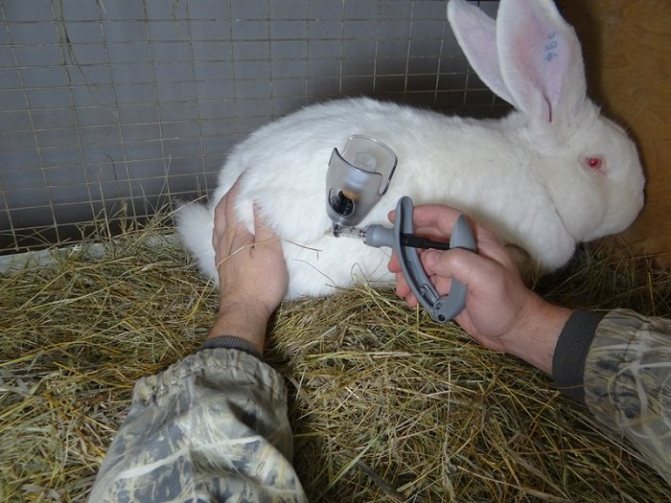

Hemorrhagic disease of rabbits on the farm can be prevented by observing the following rules:
- It is necessary to carry out planned and emergency vaccination of the livestock.
- If the disease already exists, then it is necessary to kill all individuals with signs of the disease.
- Animals with no signs should receive antibiotic therapy.
- Disinfect the premises.
- Meat can only be eaten after thorough boiling.
- The skins can also be used after being disinfected and dried.
Diseases of rabbits, dangerous to humans
Diseases of rabbits that are dangerous to humans:
- Cysticercosis... Prevention - taking antihelminthic drugs.
- Fascioliasis... Thorough hand washing after contact with animals is essential to prevent illness.
- Pasteurellosis... Regular disinfection of cells is a way to prevent infection.
- Listeriosis. Prevention - compliance with hygiene standards.
- Tularemia. Disinfection of hands and clothing is required.
Keratitis
Keratitis is an inflammation of the cornea of the eye. More often the cause of the disease is mechanical damage. Disease can be caused by chemicals or infections. Keratitis is rarely the result of exposure to the crawling parasites.
The main symptom of the disease is cloudy eyes. Tearing or purulent discharge appears. Sometimes rabbits become sensitive to light, causing them to squint.
Keratitis is treated with eye drops that relieve inflammation. It is also required to identify the cause of the onset of the disease and eliminate it. A preventive measure is the observance of sanitary and hygienic standards, the correct arrangement of the cell.
Disease prevention and vaccination
Preventive measures for various diseases are presented in the table:
| Disease | Prophylaxis |
| Coccidiosis |
|
| Myxomatosis |
|
| Pasteurellosis |
|
| Cysticercosis |
|
| Listeriosis |
|
| Tularemia |
|
| Infectious rhinitis |
|
| Worms |
|
| Ringworm |
|
| Mites |
|
| Fleas | Use of a special collar. |
| Diseases of the gastrointestinal tract |
|
Myxomatosis
Myxomatosis refers to acute viral infections and therefore is characterized by a very high mortality rate of animals - up to 100% of the livestock.
Any breed and age group of domestic and wild rodents can get sick with it. In sick and recovered individuals, the virus is found in almost all organs and tissues, including blood. Therefore, infection can easily occur not only through various outflows from patients, but also during the bites of blood-sucking insects (mosquitoes, fleas, various flies and ticks).
The disease is acute. The latent, asymptomatic period of infection is five to ten days. Myxomatosis in rabbits occurs in two types: edematous and nodular.


The edematous form in sick animals is initially characterized by blepharoconjunctivitis (in which eyelids stick together and outflows from the eyes are observed) and rhinitis (discharge appears from the nose). In the area of the anus and reproductive organs, as well as on the head, edema of a gelatinous consistency is formed, up to five cm in size, and sometimes more. Sick animals are depressed, the body temperature rises by two or three degrees, they stop eating, lose weight. Breathing becomes tense and hoarse, and the mucous membranes become bluish. The skin on the neck and head folds into a kind of roller, the ears hang down, while the head becomes like a lion's mane.
Edematous myxomatosis is characterized by a malignant course, lasts on average about a week, sometimes a month, and causes almost 100% mortality of the livestock.
The nodular form at the beginning of the course is characterized by the formation of many neoplasms on the head and ears, which can then merge, which gives the animal an ugly appearance. After a fortnight, ulcers form at the site of the nodules, which heal in the absence of complications. This type of myxomatosis lasts a little more than a month, while half of the sick population recovers safely.
If you find similar symptoms in your pets, you should immediately contact your veterinarian. Unfortunately, the treatment of this infection has not been developed, therefore, the forced slaughter and destruction of diseased individuals is carried out. In addition, a number of measures are being taken to prevent the spread of infection, as well as disinfection of premises and equipment.


There is only one way to protect yourself from this dangerous infection - it is necessary to vaccinate the entire livestock on time.
Abscesses
Some rabbit diseases require surgery. The abscesses are opened by a surgeon. They are cavities that contain pus and are located under the skin. Most often, abscesses form on the chin or muzzle. Less often, subcutaneous bumps appear on the nose of rabbits. Sometimes subcutaneous balls of different sizes are felt on the back or abdomen.
Often, purulent formations are complications after injuries. If the wound is not well treated, an infection gets into it, which begins to develop there. Also, the cause of the appearance of suppuration can be dental diseases, insect bites (mosquitoes, for example) or any other damage to the skin. After opening the abscess with pus, the animal is prescribed a course of antibiotics.
():
If the abscess cavity is large, drainage is placed. Within 3 days, the wound is washed with disinfectant solutions and antibacterial ointments are placed inside.
Cold
Many diseases in rabbits are similar to those in humans. The fluffy beast is prone to colds. A rabbit that is sick has difficulty breathing, mucous nasal discharge, reddening of the eyes and watery eyes are observed.A rabbit's cough or sneeze is more like snorting.


The main factors causing the disease: drafts, sudden changes in temperature, high humidity
A cold in rabbits goes away on its own if the causes of the disease are eliminated (low air temperature in the rabbitry, drafts, etc.). Aggravation of the situation will lead to pneumonia, which will take about a month to treat.
Eczema
Eczema is a non-communicable disease, it occurs against the background of allergies to chemicals and food. Disorders of the digestive system in a pet or diseases of internal organs - kidneys, liver - act as a provoking factor. Often, eczema develops due to the use of antibiotics, infection with helminthic infestation or skin parasites. At its core, eczema is an inflammation of the epidermis.
There are several stages of the disease, each of them has certain characteristics:
- Erythematous stage - it is characterized by redness of the skin and swelling.
- Papular - at this stage, reddish lumps form on the skin, which are not yet itchy and do not bother the rabbit.
- Vesicular stage of the disease - at this stage, papular nodules are filled with liquid contents, outwardly they resemble blisters. The pet experiences painful sensations when pressing on the affected area.
- Erosive stage - now the bubbles are gradually bursting, and instead of them small abscesses are formed. For that stage of the disease, severe itching is characteristic.
- Crustal stage - as a result of scratching the pustules, crusts form on the skin, which eventually disappear. The healing process begins.
Treatment for eczema involves the use of disinfectants to treat the skin where inflammation develops. After disinfection, antimicrobial and healing ointments are applied to the affected areas. You can also treat eczema with folk remedies, for example, ointment with copper sulfate or turpentine. They help relieve inflammation and various compresses based on herbal decoctions - sage, nettle, burdock.
Encephalozoonosis
The disease is caused by a unicellular parasite. Encephalozoonosis is often asymptomatic. If the animal's immune system is well developed, then the body can cope with the disease on its own. If the immunity is weakened, then the disease will cause the death of animals.
():
Infection occurs from sick animals. Infected individuals excrete the pathogen in urine and feces. Such animals serve as a reservoir of infection for several months and even years.
Symptoms of encephalozoonosis are convulsions, torticollis, tremors, falling on the hind legs, uncontrolled urination, disruption of the vestibular apparatus, loss of appetite and apathy.
For treatment, drugs are used that are aimed at destroying the parasite that causes the disease. By far the most effective is panakur. There are no preventive measures that can minimize the risk of parasite damage to the body.
Dermatomycosis or skin fungus
There are several types of skin fungus that cause dermatophytes. Most often, the causative agents of the disease are trichophytons and microsporums. They penetrate the layers of the skin to form filaments and multiply by spores. The mushrooms are fed by carotene, which is contained in the fiber of the skin, nails and hair of the pet. Infection always occurs against the background of a decrease in the immunity of the animal, and the provoking factors are:
- Poor nutrition.
- Stress.
- Hormonal imbalance.
- Other diseases.
Psoroptosis
The causative agent of this disease is a blood-sucking parasite belonging to the genus Psoroptes cuniculi. It is embedded in the auricle, where there are many capillaries. Most often, the disease spreads in autumn or winter, when the immunity of pets decreases. Infection occurs through contact with a sick animal.
The symptoms of psoroptosis are easy to recognize:
- The animal often scratches its ears, scratches are formed near the auricles.
- The rabbit is depressed, worried, and loses its appetite.
- With a strong infection with ticks, a serous secret is formed in the ears, which has an unpleasant odor.
- The pet lowers its ears, shakes its head.
Attention! When a secondary infection is attached, inflammation of the brain membrane may develop, which leads to the death of the rabbit.
Local treatment of psoroptosis includes cleaning the ears with hydrogen peroxide (3%), after which the auricles are treated with acaricidal sprays or formulations:
As a general therapy, injections of Ivermek or Ivomek (0.2%) are used. The drug is administered intramuscularly at a dosage of 200 μg / kg of body weight.
Cystitis
This rabbit disease is infectious in nature. The bacterial infection gets into the bladder, which causes inflammation. Cystitis often appears if the animal is already sick with any disease of the excretory system or the musculoskeletal system. Also, cystitis appears due to the lack of the required amount of drinking water or the presence of dirty water in the drinking bowl. The cause of cystitis can be a lack of vitamins. In decorative rabbits, the disease often appears if, after washing, they remain wet for a long time. Sometimes cystitis is caused by mental disorders.
():
Females are more likely to develop cystitis. Anatomically, their urethra is shorter than that of males. And the infection rises faster to the bladder. In addition, rabbits are more likely to acquire pathogens during childbirth or hunting.
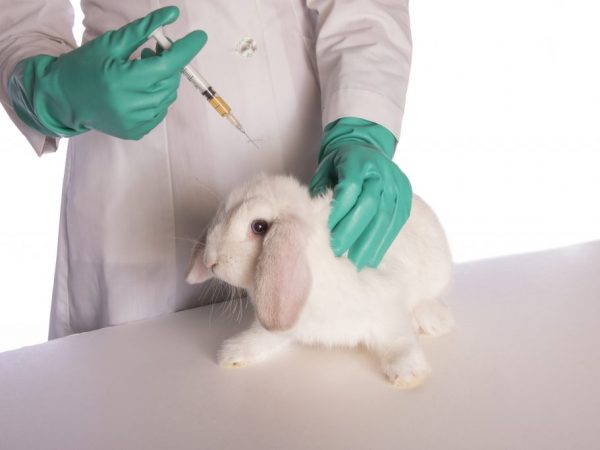

Progressive cystitis leads to weight loss, appetite, reluctance to move, and ultimately death
Symptoms of diseases of rabbits associated with the urinary system include painful and frequent urination, swelling in the genital area, and decreased appetite. In sick rabbits, the hair in the genital area is wet and dirty.
Cystitis is treated with antibiotics and analgesics. The drugs and their dosage should be prescribed by a doctor. If it is not possible to turn to him, it is allowed to treat cystitis with Baytril in combination with trimethoprim. Baytril is not prohibited even for the treatment of young rabbits. The dosage is indicated in the instructions for the drugs. From analgesics, preference should be given to metamizole or movalis.
Animals must have clean water, fortified food and proper housing conditions. These measures are preventive.
Listeriosis
Infectious diseases of rabbits, which include listeriosis, are the most dangerous. Sick animals, some blood-sucking parasites, small rodents spread the infection.
Rabbits with listeriosis are often unable to conceive. Those animals that manage to get pregnant give birth to non-viable offspring. Rabbits live no more than 6 days. Sometimes death occurs already on the first day. Also, the disease is accompanied by partial paralysis.
To date, no treatment has been developed for listeriosis in rabbits. Sick individuals are destroyed. Their meat is not edible. Prevention consists in compliance with sanitary and hygienic standards and the use of quality feed.
Aymeriosis
The disease is a consequence of the vital activity of the protozoa that live in the intestines or liver. The rabbit is capable of transmitting the parasite to offspring during feeding. Animals can become infected by being in a poorly ventilated room where this parasite is present.
Aymeriosis causes a sharp weight loss in animals, decreased appetite, lethargy. Symptoms of the disease in the later stages of development are diarrhea and frequent urination. Blood is often present in liquid stool. Eymeriosis is often accompanied by eye inflammation.
Rabbits are treated with sulfonamides. Preparations Dissolve in clean water. It takes at least 3 days to water sick animals. Starting treatment at an early stage of the development of the disease, they get rid of it in 3-5 days. With an advanced form of the disease, animals are drunk for more than 5 days. The treatment process should take place under the supervision of a physician. Prevention of sore is the observance of sanitary and hygienic standards.
Home treatment
In case of coccidiosis, which is an invasive disease, animals are fed with baikoks. Bikebox is used for rabbits, treatment of birds and some representatives of cattle. It is also important to solder them with trichopolum. For the prevention of coccidosis, it is important to give rabbits a drink with a weak solution of iodine. The iodine solution helps to improve the immune qualities of the body.
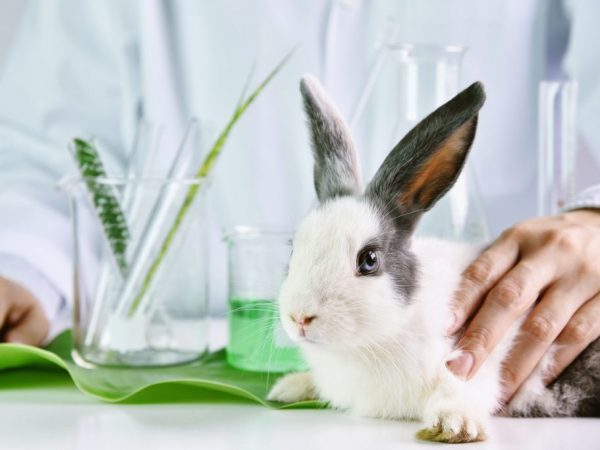

The best prevention against all ailments is a comfortable living environment
Constipation is treated with petroleum jelly. Signs of constipation include bloating and no stool. Intestinal diseases are often caused by poor nutrition. You cannot give food that has already begun to deteriorate. Also, intestinal diseases occur due to violations of sanitary and hygienic standards.
When tympanic, massage is done. If it does not help, seek help from a veterinarian. Traditional methods of treatment are ineffective. Enteritis is treated with oxytetracycline.
They can bring a lot of inconvenience and ear diseases to rabbits, in the event of which the individuals will have to be soldered with penicillin. The dose should correspond to that indicated in the instructions. Wounds and ulcers are cauterized with methylene blue.
Novice rabbit breeders should always have a first-aid kit with drugs intended for the treatment of various types of diseases. The most dangerous are viral ailments. There should also be drugs that treat non-communicable diseases.

